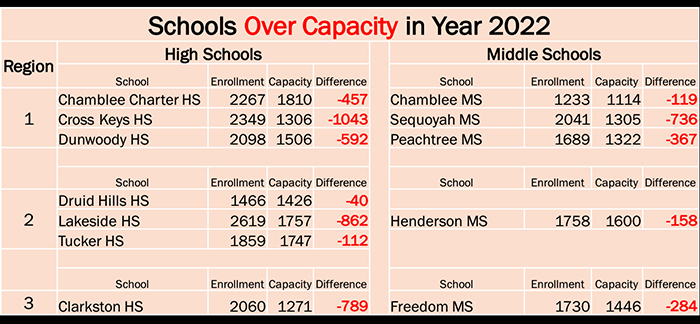
How do you make a big school district feel small?
None of the state’s solutions will work county wide in DeKalb. A System of Charter Schools? There are too many schools to have a district of locally governed charters schools. A System of Clusters? Some communities in the county don’t have school councils much less have the capacity to govern an entire cluster.
NYC Public Schools
Superintendent Stephen Green worked at the New York City public school system, the largest in the world with more than 1.1 million students. NYC public schools is broken down into 32 Community School Districts where Dr. Green was the Superintendent of Community School District #28.
So, How do you make a big school district feel small?
DeKalb Schools already groups clusters into 5 regions with 5 Regional Superintendents. Dr. Green seems to be recreating the Community School Districts giving autonomy to a Micro Cabinet administration for each Regional Superintendent. How much autonomy? “Autonomy is earned”, says Dr. Green. The central office will hopefully move to a service model servicing the micro cabinets needs.
Division of Regional Superintendents
| Micro Cabinet Teams | |||||
|---|---|---|---|---|---|
| Position | Region 1 | Region 2 | Region 3 | Region 4 | Region 5 |
| Regional Superintendent | Sherry Johnson (Interim) | Trenton Arnold | Rachel Zeigler | Triscilla Weaver | Ralph Simpson |
| Coordinator Leadership | Sherry Johnson | Makeba West | Tangela Kimber | Linda Crowley | Wilfred Johnson |
| Executive Assistant | Lorraine Sanford | Darla Gilstrap | Elicia Moore | Cheryl McEwen | Sonya Taylor-Clunie |
| HR Manager | Julie Fincher | Antoinette Seabrook | Jatisha Marsh | Anglelica Collins | Tracia Cloud |
| HR K-12 Secretary | Cynthia McKenzie | Ariel Baker | Dijon DaCosta | Kenyarda Berrian | Dorothy Norton |
| Curriculum And Instruction | Kristie Fountain, Andrea Wright, Dr. Darryl Felker, Jeffrey Dillard | Annette Howell, John Hruby, Kismet Sims, Devetra Ushery | Norrie Mills, Jamilla Williams, Lashawn White, Michelle Bateman | Christine Morgan, Cathy Harris, Gary Jordan, TBD | Dr. Latonya Brown, Maya Kirk, Monica Vestal-Mashburn, Dr. Michelle Thompson |
| Technology | Laura Crate | Reese Azar | VACANT | Terri Webb | Angela Johnson |
| Maintenance Supervisor | Winward Hines | Arthur Kinder | Stephen Boyd | Christoper Young | Fred Schoenfeld |
| Finance | Deborah Burns | Melissa Jefferson | Vernon Crosby | Chris Smith | Cynthia Prather |
| Transportation | Harold Lewis | VACANT | David Guillory | Pam Sanders | Kevin Phillips |
Cabinet Position Descriptions
Regional Superintendent – Supervises and supports principals and communities in assigned region. Example: Evaluate principals and monitor instructional data.
Coordinator Leadership – Under the direction of the regional superintendent, serves as a resource to principals. Example: Serves as a representative for the regional superintendent; monitors field trip approvals.
Executive Assistant – Reporting to the regional superintendent provides clerical and administrative support to the regional superintendent. Example: Expense reports.
Human Capital Manager – Reporting to the regional superintendent, partners with principals to staff schools and work on employee concerns. Example: Recruiting job candidates.
Human Capital K-12 Secretary – Reporting to the Human Capital Manager, provides administrative support for the human capital function in the assigned region. Example: Scheduling new employees for orientation and onboarding.
Curriculum And Instruction – Serves as a liaison between the assigned region and the Division of Curriculum and Instruction. Also supports the Horizon and OSD schools in the assigned region. Example: Conducts professional learning at the schools.
Technology – Serves as a liaison between the Division of Technology and the assigned region. Facilitates the implementation of technology initiatives throughout the region. Example: Trains staff members on instructional technol-ogy programs and applications.
Maintenance Supervisor – Facilitates maintenance services to the schools. Example: Monitors responsiveness of maintenance requests. The school principal and council enter capital project needs into the “School Dude” maintenance system. The Regional Superintendent and Maintenance Supervisor prioritize and schedule regular maintenance and minor repairs. Major capital improvements like HVAC replacements will have to be approved by the Chief Operating Officer.
Finance – Assists with monitoring financial activity including utilization of school funds. Example: Ensures alignment of expenditures with instruction.
Regional Transportation Manager – Supervises, monitors and ensures an adequate supply of bus drivers for the assigned region. Example: Maintaining pupil transportation routes.






















 “Extremism in defense of liberty is no vice. Moderation in pursuit of justice is no virtue.”
“Extremism in defense of liberty is no vice. Moderation in pursuit of justice is no virtue.”